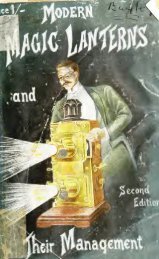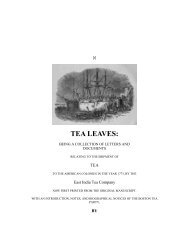The Art of projection and complete magic lantern ... - Yesterday Image
The Art of projection and complete magic lantern ... - Yesterday Image
The Art of projection and complete magic lantern ... - Yesterday Image
- No tags were found...
You also want an ePaper? Increase the reach of your titles
YUMPU automatically turns print PDFs into web optimized ePapers that Google loves.
69to reach our compressors without detection, such however has happenedmore than once <strong>and</strong> although I am glad to say no serious injury hasever occurred through ignition <strong>of</strong> gases <strong>and</strong> consequent explosion in acylinder, we have had alarming experiences, <strong>and</strong> narrow escapes fromserious accidents. I may point out that these are accidents which couldonly occur during compression, <strong>and</strong> are consequently risks to which we<strong>and</strong> not the customer are exposed. Such experience is now very rareindeed, as the danger is more generally known, <strong>and</strong> I may add that asan absolute safeguard in addition to colour we now ma'ke all connectionsfor oxygen <strong>and</strong> coal gas different <strong>and</strong> consequently non-interchangeable,<strong>and</strong> when this is universally adopted, the real <strong>and</strong> I may say onlyelement <strong>of</strong> danger in our business will be practically done away with."" How do you account for such explosions <strong>of</strong> coal gas <strong>and</strong> oxygen ? "" That is a difficult question to answer, they are undoubtedly due tosufficient heat being generated in some portion <strong>of</strong> the cylinder tocause ignition <strong>of</strong> the two gases."" It may be dueto a variety <strong>of</strong> causes. <strong>The</strong> actual compression <strong>of</strong> thegases causes a certain amount <strong>of</strong> heat, but this alone is not sufficient toexplain the occurrence. It can only be that (owing to, in part, thecompression, but to a much larger extent—the friction caused in thevalve passages which may be full <strong>of</strong> oil or hydro-carbon deposit, <strong>and</strong> thesudden impact <strong>of</strong> the gas rushing into the cylinder) sufficient heat iscaused locallyto ignite an explosive re-action <strong>of</strong> gases, <strong>and</strong> <strong>of</strong> course themoment ignition takes place enormous heat <strong>and</strong> pressure iscreated insidethe cylinders. A cylinder which has been long used for coal gas lendsitself most to such accidents, as it would be coated inside with a lining othydro-carbon deposit."" When oxygen escapes from a cylinder in any quantity, it is noticedthat the flow is very uneven. How do you account for this ? "" This should only occur when oxygen is allowed to escape veryrapidly from the cylinder <strong>and</strong> then the explanation is very simple. It isjust the reverse <strong>of</strong> what takes place when the gas is compressed. <strong>The</strong>highly compressed gas in the cylinder has by the time it is used cooleddown to the temperature <strong>of</strong> the surrounding atmosphere. This largevolume <strong>of</strong> gas when exp<strong>and</strong>ed out <strong>of</strong> the cylinder, abstracts the heatfrom the surrounding atmosphere, with the result that such an intensecold is generated immediately round the cylinder as to create ice fromthe moisture present <strong>and</strong> this ice getting into the valve passages c auses





